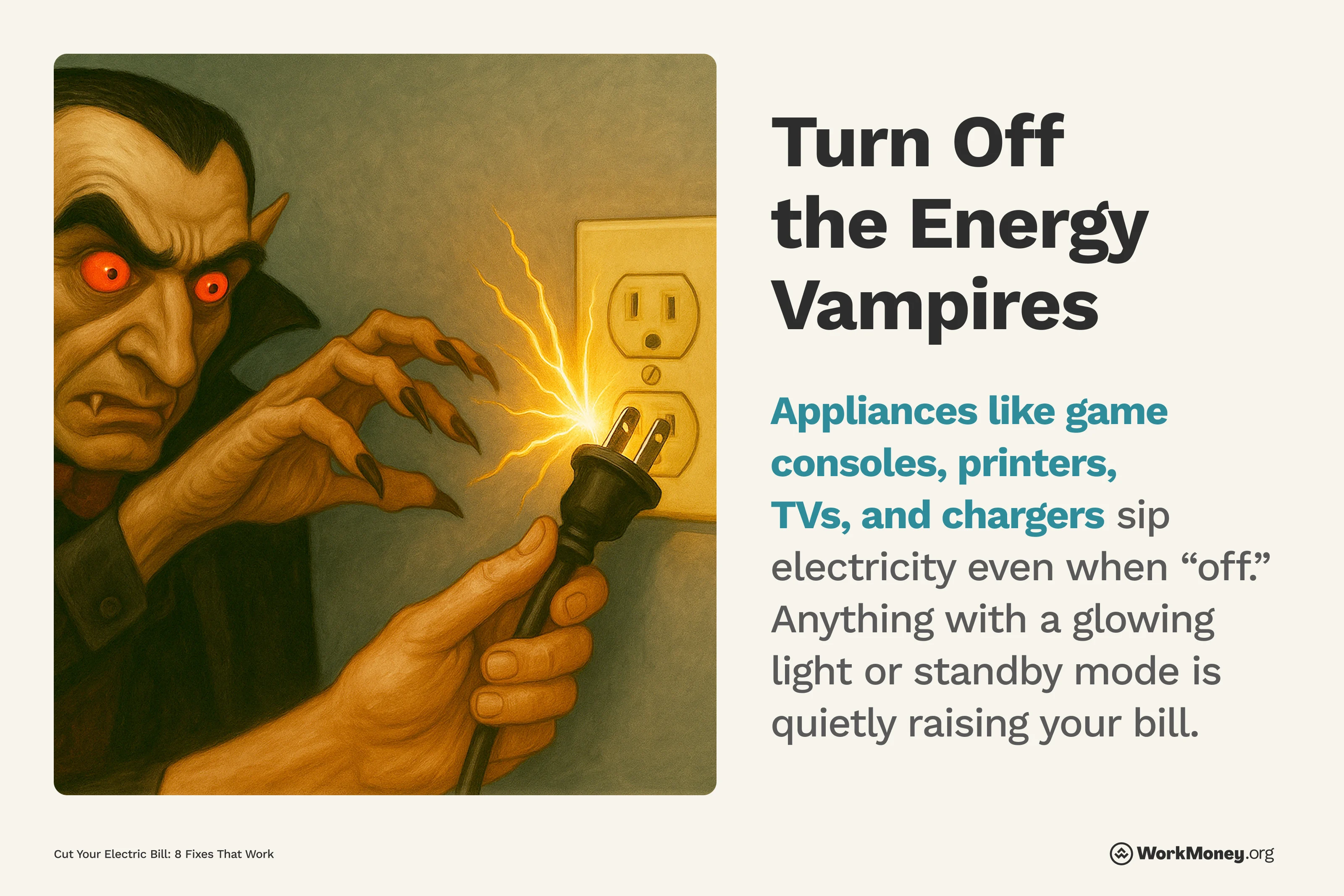Cut Your Electric Bill: 8 Fixes That Work
Cut your electricity costs without sacrificing comfort—these smart, practical tips can help you save money year-round and even get cash back on your utility bills.

Electric bills are hitting households hard—especially with rates climbing and weather extremes pushing heating and cooling systems into overdrive. A 2025 survey by PowerLines of 2,000 U.S. adults found that 73% are worried about rising utility costs, and nearly two-thirds said their gas and electric bills have gone up in the past year.
Whether you're a renter or a homeowner, WorkMoney is dedicated to helping readers find ways to save on utilities. We found some easy ways to cut costs without sacrificing your family’s comfort. Even better—we’ll show how to get some of the money you spent on your electricity bill back.

1. Turn Off the Energy Vampires
Even if you don’t blast the AC and are thoughtful about turning lights off, your home is likely using up more energy than you would expect. Appliances like game consoles, printers, TVs, and chargers sip electricity even when “off.” Anything with a glowing light or standby mode is quietly raising your bill. According to the Department of Energy, standby energy usage accounts for five to 10$ of residential energy use, costing the average U.S. household up to $100 per year.
Unplugging these devices when not in use will help you save money. You can install a power strip with an on/off switch that can let you turn off multiple devices at once to make this task even easier.
2. Tame the Thermostat
Don’t randomly set your thermostat based on your mood. While it’s tempting to blast icy cold air in the summer, try to cap it at 78°F in the summer. For winter, stick with 68°F. Every degree you adjust your thermostat can increase your heating and cooling spending.
Programmable thermostats can return the purchase cost in a year.
3. Turn on Appliances during Off-Peak Hours
It’s time to start scheduling your chores so you don’t accidentally overspend on everyday necessities. Households with time-of-use electricity plans can save money simply by being strategic about when they run their washer and dryer or dishwasher. Doing laundry or dishes during peak rate times (usually 4 to 9 p.m.) costs more. If possible, run loads early morning or late evening instead. This is a great fix for renters who aren’t able to invest in long term fixes like installing solar panels.
If you aren’t sure how you accumulate electricity charges, check your electric bill or call your provider to ask if you’re on a time-of-use plan.
4. Apply for Financial Assistance
If you need help slashing your electricity bill, consider enrolling in an assistance program like the Low Income Home Energy Assistance Program (LIHEAP). This program helps with utility bills during extreme cold or heat. Some states also offer emergency assistance for shutoff notices. On average, LIHEAP program participants save $539 per year. This program is available to both homeowners and renters.
Government programs are a great place to start, but if your income doesn’t qualify, you need to turn your attention to your electricity provider. Many utility providers offer budget billing (which can help even out high seasonal bills), hardship programs, and forgiveness plans for overdue balances. Call your provider or check your state’s Public Utilities Commission website.
5. Get a Home Energy Audit
If you’re stumped as to why your energy bills are so high, it might be time for a home energy audit. Many utilities offer this service for free or a low rate. The way it works is a specialist will assess your home and show you exactly where energy is being wasted. They may even provide you with immediate solutions like installing LED bulbs or door sealing kits on the spot.
If professional support is out of reach, you can also conduct a home energy audit on your own. Having a professional inspect your home will generate the best results, but these are some steps you can take to audit your home energy use:
Look for drafts. Walk around windows, doors, baseboards, and where walls meet ceilings to feel for air leaks
Check for gaps around outlets and switches. These small openings can leak air and often go unnoticed
Inspect windows and doors. See if daylight is visible around frames or if they rattle in their frames
Examine exterior walls. Check where different building materials meet for potential leak points
Test fireplace dampers. Make sure they close tightly when not in use to avoid energy loss
Observe combustion appliances. Look for soot or smoke near burners and vents that may indicate poor ventilation
Peek into the attic. See if insulation covers the entire attic floor and check for gaps around pipes or ducts
Check for a vapor barrier. Look under attic insulation for paper, plastic, or a painted ceiling layer that blocks moisture
Inspect attic vents. Make sure they’re not blocked by insulation to allow proper airflow
Probe wall insulation. Turn off power and gently check behind an outlet box with a non-metal tool to detect insulation
Examine crawlspaces and basements. Look under floors and along walls for insulation and signs of moisture
Check ductwork for streaks. Dust lines around seams can indicate air leaks
Inspect HVAC filters and age. Dirty filters or outdated systems can hint at inefficiencies
Review lighting types. Take note of bulb types and wattages to assess potential overuseNote plugged-in electronics. Document items that stay plugged in even when not in use for energy monitoring later
Log appliance ages and usage habits. Older or heavily used appliances may be less energy efficient
Track energy bills. Compare usage over time to identify seasonal spikes or unusual patterns
Use a thermometer or thermal camera. Spot temperature differences around windows, doors, or walls
6. Switch Electricity Suppliers
If you live in a deregulated state, you aren’t required to stay with your current electricity supplier. Services like Arbor automatically switch you to the lowest rate—with no interruption or effort on your part. On average, you can expect to save $593 per year.
Examples of deregulated states include Texas, Pennsylvania, Ohio, Illinois, and New York. If you're not sure, you can review this map from electricchoice.com.
7. Stack Rebates for Appliance Upgrades
Rebates require a bit of work on the homeowners part, but stand to help them save a lot of money. Many states offer stackable rebates, so it’s worth seeing what rebate opportunities are available to you in your state.
See what rebates are available in your state using WorkMoney’s HEERA and utility savings map.
8. Get a Solar Quote
Going solar can cut your electric bill significantly depending on system size and your utility rates. But don’t go with the first sales rep that knocks. Use a marketplace like EnergySage to compare vetted installers and financing options side by side. You can save anywhere from 5 to 15% on your energy bill through EnergySage’s community solar option. Ask around for some free quotes with local solar panel installation companies to get an idea of how much this home upgrade will cost you and how much you stand to potentially save on your energy bills.
About the Author

Jacqueline DeMarco
Jacqueline DeMarco is a seasoned personal finance writer with over seven years of expertise covering important financial topics like credit cards, budgeting, banking, and insurance. Her work has been featured by top financial brands and publications, including Newsweek, Fortune, USA TODAY Blueprint, Bankrate, CreditCards.com, SoFi, and Northwestern Mutual.
